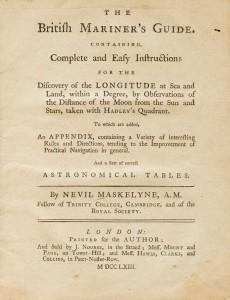As there is less than a month left to see the Ships, Clocks & Stars exhibition at the Folger Shakespeare Library in Washington DC, it’s a good time to remark on a few connections between the Folger name and the longitude story. Firstly, I should explain that the word ‘faculized’ is a Nantucket term, used to describe a distinguished and learned person, used by Harriet M. Grover in her privately printed booklet of eminent Folgers. The first mention should really go to Henry Clay Folger (1857-1930), past Chairman of Standard Oil of New York, as the Library, is his legacy. It was built to house Henry’s extraordinary collection of Shakespeare and other works from the renaissance on.

The second Folger, Walter (1765-1849), is mainly remembered as a politician and lawyer, but also as a clockmaker. An astronomical clock of his making can be seen at the Nantucket Historical Association Whaling Museum.

His connection to the exhibition is related by William Mitchell (likely the father of the astronomer, Maria Mitchell), who wrote of the adolescent Walter:
He was afflicted with ill health, and much of the time confined to his bed, begging constantly for books, which seemed the only needful opiate. There were few books at hand adapted to his taste; but his father finally succeeding in obtaining for him a work on navigation, to which for the first time was appended Dr Maskelyne’s method of obtaining the longitude at sea by means of lunar distances. This delighted him, at the age of eighteen, prostrated by sickness; he familiarized himself with the problem, and the engagement so diverted his mind from his infirmities that he speedily regained his health.

Nevil Maskelyne, 1763
The third and final Folger was instrumental to the extraordinary journey and ultimate survival of Larcum Kendall’s second timekeeper, K2. Mayhew Folger (1774-1828), also from Nantucket, rediscovered Pitcairn’s Island in 1808. When heading ashore to search for seals, he was surprised to see smoke, for the island had been described by its discoverer, Carteret, as uninhabited. Greeted by the children of the Bounty mutineers, Mayhew only spent around five hours on the island. During his brief visit he met with the last surviving mutineer, known as Alec Smith, and traded his silk handkerchief for the Bounty’s compass and timekeeper, K2.

Here are three very different members from one of America’s early European families, each with a very different connection to the exhibition: an oilman, a whaler and a teenager that was persuaded to leave his bed by The British Mariners’ Guide. So if you are in the Washington DC area before August 23rd, why not drop into the Folger, enjoy the exhibition and, maybe, get a little 'faculized.'